Farm Musings ARCHIVE . 2020
A Slight Change of Plans
March 22, 2020
As the farmers market season approaches, we are already getting questions about whether the Canterbury Community Famers Market will happen and when or how our products will be available. The COVID-19 crisis has impacted farmers markets and access to food all across the country. It is making people nervous, justifiably. With those concerns in mind, I’d like to update you on what’s happening with our farm and how you can get our products in the months to come.
First and foremost, The Canterbury Community Farmers Market Association is moving forward as if the market will open on June 3rd. I’m on the CCFMA board and we have been meeting monthly to plan the year and come up with solutions to address COVID-19 concerns. Stay tuned to the The Canterbury Community Farmers Market website and social media pages for updates. Sanborn Meadow Farm will be at the market as we have for the past 3 years. We can’t wait!
In the unlikely event the market is not allowed to open, we will come up with alternative ways to get our products to you, our valued customers. Call ahead ordering and pick ups, farm shares for cash-free buying and delivery, buying at the farm are all options we are considering. Many of our products will also be available at the Canterbury Country Store.
Food safety. My procedures for growing, harvesting and selling our products won’t change significantly as I always operate with food safety in mind. For the most part, I am the one person cutting, hydrocooling, packing and bagging vegetables. My husband may pick peas or beans once in a while when the busy season hits but every morsel of food that leaves our farm has my eyes on it at least once. All equipment is cleaned and sanitized before and after use, gloves are worn when harvesting, hydrocooling and packaging greens, produce and eggs are kept refrigerated. The one big change we will institute this year is most produce will be pre-bagged, meaning no loose greens at the market. The only exception might be large tomatoes. All greens, beans, peas, carrots, cherry tomatoes will be in plastic bags, unless otherwise requested when pre-ordering. Although there is no evidence that the virus can be transmitted through food, we realize that people will be more comfortable with produce that has not been touched by other customers.
Chickens are back!!! Or will be... We are bringing poultry back to the farm after a year or so off to do some pasture improvement work. Our new laying flock is coming in early May and should be laying by early June. As with our previous flock, they will be rotated on pasture and fed organic soy-free feed, plus all the pasture bugs and grasses, vegetable scraps, and tomato horn worms they can eat. Best eggs in town! We will have a couple of batches of broilers this year, the first ready in late June. They will also be rotated on pasture and fed organic feed (not soy-free). We are going to try raising turkeys on pasture for Thanksgiving, also using organic feed. Broilers and turkeys will be processed here at the farm, not shipped out to a slaughterhouse. Both the broilers and turkeys will be in limited quantities so stay tuned to our website and social media pages for availability announcements.
Farm Shares! We offered farm shares early in the year as a way to offset the spring start up costs and have a convenient "tab" that our customers could use when shopping at the farmers market. We are extending the deadline for farm share purchases – there is no deadline this year! Purchasing a farm share offers you multiple benefits:
- You will receive $10 extra for every $100 share purchased, up to $50 for a $500 share.
- You won’t need cash at the market. Your purchases will be recorded and deducted from your share total. We will notify you when your "tab" gets low, in case you’d like to add more.
- You will receive an email each week with what is available that week. You can then, if you’d prefer, send us a list by Tuesday of what you’d like to purchase and you can pick up your pre-packed bag of goodies at the market on Wednesday OR have it delivered to your doorstep (locally, within 20 miles) on Thursday.
- All of our products – vegetables, poultry, eggs, honey – can be purchased with your share dollars.
- You will be supporting a local farm devoted to bringing good food grown responsibly to our community. Your dollars stay with a small local business you know and trust!
- View/Print Farm Share Form
As always, if you have questions about our products or how to purchase products, feel free to send us an email at sanbornmeadowfarm@gmail.com or a message on our Facebook page. We hope to see you at the market in June!
Who’s Your Farmer?
March 19, 2020
Recent days have been a challenge for many of us. The prospect of a novel virus running rampant is scary for sure. Add in the panic over food and supplies, the empty store shelves, the feeling that one must hoard food because it surely is about to run out, one could be forgiven for thinking the end of days had come. Fear not. The virus will run its course (I’m hopeful the measures currently in place will reduce lives lost) and there is plenty of food right now and for the future. Where is all this elusive food not on the supermarket shelves? Farmers. All the farmers and producers you see at farmers markets, at roadside stands, that cottage baker on Facebook, your jam-making neighbor, that grass-fed beef operation down the road you’ve always meant to visit. They have food and lots of it, available now.
After this crisis passes, and it will, I hope we focus a little bit more on the glaring flaws in the increasingly centralized food system. The big chemical corn/soy producers like to crow "we feed the world" but that couldn’t be further from the truth. More than 70% of the world’s food comes from small farmers. There is plenty of food. The real problem is distribution, either due to geography, government limitations or corruption. What we see in the local supermarket now is not a lack of food but an inability of the distribution system to keep the shelves stocked during an increase in buying. A supermarket chain may have only one central warehouse in each region from which supplies are sent to the stores. There are only so many trucks available, hours in the day to load them and shipments of produce from Mexico and other countries coming into port. Supermarkets were touted in the early 20 th century as a "one-stop" shop for the busy consumer, and for the most part this seemed to work for us. However, the modern streamlining, consolidating, just-in-time delivery formula for reducing costs now has almost zero tolerance for upset. Our food security is dependent on a system that has limited ability to handle disruptions to the supply chain.
Meanwhile, 40% of food produced in this country goes to waste and your local farmer struggles to find enough customers to buy her produce or pastured eggs at a price that a meager profit can be had. There are farmers across the country right now that could step in and supply local supermarkets with all sorts of food. Unfortunately, the supermarket parent companies don’t want to do business with multiple small local farms to supply the volume they get from one mega farm in Mexico or hydroponic operation in Canada. What if we opt out of this centralized food system and just buy from our local farmers, bakers and cottage food producers directly, like our grandparents did before the invention of supermarkets? Or frequent the local food co-op that has brought together products directly from local producers and pays them a fair price? Now admittedly, in the Northeast, there are limits to local food production due to the winter climate. You won’t find fresh strawberries right now but if you search around, you’ll find strawberry preserves or frozen strawberries as well as farmers who have mastered season extension and have delicious greens available. There are still loads of root vegetables to be had, local meats of all kinds, eggs, maple products, canned and preserved fruits and vegetables, baked goods…the list goes on.
Yes, you’ll pay more than you would in the supermarket, because their prices reflect the true, unsubsidized, uncommodified, non-wholesale cost of real food and these folks deserve to make a living doing their work. You won’t find "hot pockets" or processed soy-based fake food, none of which we should be eating anyway, but you will find real, unadulterated, nutritious food to feed you and your family. Once we’ve come through this challenge, give yourself a new challenge. Seek out your local producers, try their goods, ask questions about their growing practices. Develop your own resilient, de- centralized food system for at least a portion of your regular food shopping. This will have the added bonus of getting to know your neighbors and fostering a sense of community and security. In times of crisis, we could sure use more of that!
As a start, and far from complete, here is a list of local farms and businesses that have wonderful products available now. Most have Facebook pages as well so be sure to check out recent posts concerning availability during the coming weeks:
- Brookford Farm, Canterbury
- Miles Smith Farm, Loudon
- Marsh Meadow Bison, Canterbury
- Fox Country Smokehouse, Canterbury
- North Family Farm, Canterbury
- Hutchinson Family Sugarhouse, Canterbury
- Work Song Farm, Hopkinton
- The Downtown Concord Winter Farmers Market announced they were shutting down for a while but they posted a list of vendors’ contacts on their Facebook page
Seed Magic – A Botany Lesson
March 1, 2020
The most exciting time for any vegetable farmer or gardener is when the first seeds get planted, whether it be into flats under grow lights or in the soil outside. An entire growing season’s hopes and dreams are contained in these tiny hard coated mystery pebbles. But how do seeds go from seemingly lifeless lumps to lush green, productive vegetable plants in the span of just a few weeks? I’m going to put my Botany 101 Teaching Assistant’s hat back on and divulge a little behind-the-scenes (and much condensed) peek into how seeds work.
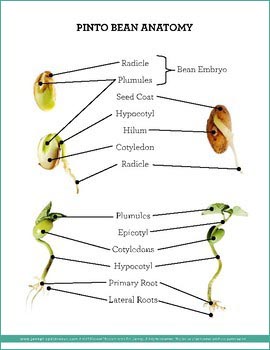 Everything needed to grow a plant is contained inside the hard shell (see diagram).
The young seedling is called a plumule, the first main root is the radicle, and together they are called the embryo. The embryo is curled up between a pair of cotyledons, which are the young seedlings food source before the first leaves emerge. Most common vegetable seeds are dicots, or have two cotyledons. Corn and grasses are monocots, having one cotyledon or endosperm. There are some fuzzy lines in this definition but that is for another, more plant nerdy conversation. The seed coat protects all of these structures physically and keeps the right amount of moisture inside. Seeds kept in dry and cool conditions can remain viable for years, so don’t throw out last year’s seeds!
Everything needed to grow a plant is contained inside the hard shell (see diagram).
The young seedling is called a plumule, the first main root is the radicle, and together they are called the embryo. The embryo is curled up between a pair of cotyledons, which are the young seedlings food source before the first leaves emerge. Most common vegetable seeds are dicots, or have two cotyledons. Corn and grasses are monocots, having one cotyledon or endosperm. There are some fuzzy lines in this definition but that is for another, more plant nerdy conversation. The seed coat protects all of these structures physically and keeps the right amount of moisture inside. Seeds kept in dry and cool conditions can remain viable for years, so don’t throw out last year’s seeds!
What causes a seed to split open and push its bits into the sunlight? The first step is called imbibition, a fun word to pull out at your next party. When you plant your seed, you give the soil a good soaking. The seed coat is not impermeable and so the water seeps into the seed, rehydrating the sleeping plant cells and swelling the tissues. The tiny plant’s metabolism gets a jump start too. The resulting pressure of swelling cells cracks open the seed coat. This process is why it is important to keep the soil consistently moist until you see the seedlings emerge. Letting the soil dry out at this point can delay or even stop germination.
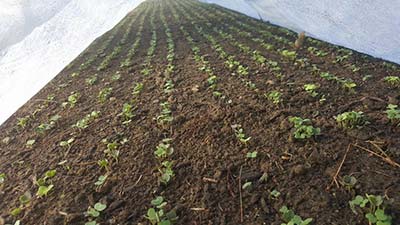 Light plays a role in germination too. Some seeds won’t germinate unless there is also some light. Lettuce is a good example. Lettuce seeds should be just barely covered with soil so that light can penetrate the seed. Onions, on the other hand, do best when covered with soil and not exposed to sunlight. For some vegetables, light does not influence germination. There isn’t much need for us to know which is which – just follow the sowing directions on the packet or in the catalog to make sure you are planting your seeds at the correct depth.
Light plays a role in germination too. Some seeds won’t germinate unless there is also some light. Lettuce is a good example. Lettuce seeds should be just barely covered with soil so that light can penetrate the seed. Onions, on the other hand, do best when covered with soil and not exposed to sunlight. For some vegetables, light does not influence germination. There isn’t much need for us to know which is which – just follow the sowing directions on the packet or in the catalog to make sure you are planting your seeds at the correct depth.
Once the seedling pushes its head out of the soil and the radicle burrows down into the soil to form the root system, the cotyledons pop out and open up to the light. It will be some days yet before the seedling can grow its first set of true leaves so the energy stores contained in the cotyledons will get the seedling through until it can start photosynthesizing and making its own food. During this early growth stage, there is no need to fertilize. In fact, fertilizing can easily burn the tender seedlings, so it is best to hold off on extra fertility until the young plant has formed it’s first leaves. If your potting soil or garden soil contains a good amount of compost, it may not be necessary to fertilize for several weeks. If starting seeds in flats, the constant watering needed to keep the soil damp will tend to flush out nutrients so you will need to fertilize sooner than if working out in the garden beds. If growth lags or the plants starts to yellow, a fertilizer boost is needed.
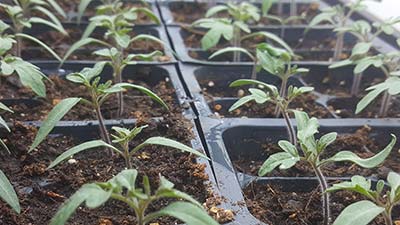 On our farm, onion seedlings are already growing under lights in the warmth of our house. Over the next few weeks, I will be starting many of the other vegetables we will grow this year along with the vegetable starts I plan to sell at the first farmers market in June. Soon, our house will be overflowing with flats of emerging seedlings and young plants. I will be carefully watering and assessing their needs daily, cheering them on, excited to get them into the garden. The seed starting process never gets old for me, a certified Botany nerd. I’m always excited and a little bit in awe each time flats of sown seeds push up their little heads into the light. "As if by magic", a former work colleague used to say, something is created from seemingly nothing, and the growing season begins anew.
On our farm, onion seedlings are already growing under lights in the warmth of our house. Over the next few weeks, I will be starting many of the other vegetables we will grow this year along with the vegetable starts I plan to sell at the first farmers market in June. Soon, our house will be overflowing with flats of emerging seedlings and young plants. I will be carefully watering and assessing their needs daily, cheering them on, excited to get them into the garden. The seed starting process never gets old for me, a certified Botany nerd. I’m always excited and a little bit in awe each time flats of sown seeds push up their little heads into the light. "As if by magic", a former work colleague used to say, something is created from seemingly nothing, and the growing season begins anew.
2019 Came and Went
January, 2020
Happy New Year! 2020 is here and 2019 is but a distant memory. Despite my best intentions, I wrote exactly ONE blog entry last year, filled with all the promise that an emerging spring provides. It always amazes me how quickly the reality of the market season arrives and then it's full speed ahead into controlled chaos.
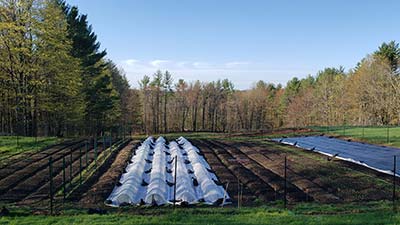 2019 was a good one for us. The market garden was more productive than ever, meaning all that time and money spent on equipment and training began to pay back. Our sales at the Canterbury Community Farmers Market and the Canterbury Country Store increased significantly thanks to a loyal following of customers (a BIG Thank You!). The pasture work was finally completed in July. Our land was too wet this past spring to bring in the heavy equipment to finish the work that was started in fall of 2018 so we had to wait…and wait. Our fall was spent cleaning up the newly opened land, applying lime, and then seeding with pasture mix, hopeful that we had enough time to get some good growth before winter. The pasture mix sprouted quickly and a promising new green carpet popped up just as the leaves were falling. Being poultry-free this year allowed me the time to finish the long-anticipated perennial garden behind the house. I am eagerly awaiting spring and summer to see how the newly transplanted perennials grow and fill in. The garden includes lots of bee-friendly plants so our pollinator friends should be happy. There were a few other projects around the farm that were finally finished. All in all, 2019 felt like a reset year.
2019 was a good one for us. The market garden was more productive than ever, meaning all that time and money spent on equipment and training began to pay back. Our sales at the Canterbury Community Farmers Market and the Canterbury Country Store increased significantly thanks to a loyal following of customers (a BIG Thank You!). The pasture work was finally completed in July. Our land was too wet this past spring to bring in the heavy equipment to finish the work that was started in fall of 2018 so we had to wait…and wait. Our fall was spent cleaning up the newly opened land, applying lime, and then seeding with pasture mix, hopeful that we had enough time to get some good growth before winter. The pasture mix sprouted quickly and a promising new green carpet popped up just as the leaves were falling. Being poultry-free this year allowed me the time to finish the long-anticipated perennial garden behind the house. I am eagerly awaiting spring and summer to see how the newly transplanted perennials grow and fill in. The garden includes lots of bee-friendly plants so our pollinator friends should be happy. There were a few other projects around the farm that were finally finished. All in all, 2019 felt like a reset year.
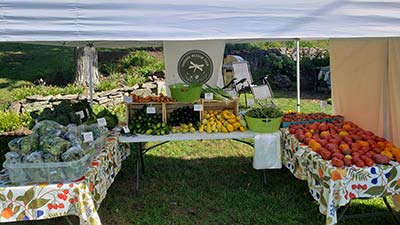 This year, we hope to take our farm to the next level. For us, that means birds. Poultry, more specifically. We will bring in a new egg-laying flock this spring, sourcing 16-week old pullets so that we can be in production by the start of the farmers market season. We will also raise multiple batches of meat chickens throughout the summer. And finally, we plan to take our first foray into the world of turkeys, raising a small batch for a Thanksgiving harvest. In the market garden, I will continue to optimize the crop mix to produce vegetables that our customers really want. As much as I'd love to grow everything, and am still tempted by the abundance of possibilities in seed catalogs, the truth is that no one understands kohlrabi or mizuna (except maybe Beth!). Taking up any of my limited garden space to grow vegetables that are interesting but don't sell is not a good business practice. So, there will be more greens and a healthy assortment of the regulars (tomatoes, cukes, squash, beans, carrots, onions, etc.), all grown to the best of my ability using organic practices in ever-improving living soil. We've added a couple of tools that will help reduce labor, freeing up time to either grow more vegetables or focus time on other farm activities.
This year, we hope to take our farm to the next level. For us, that means birds. Poultry, more specifically. We will bring in a new egg-laying flock this spring, sourcing 16-week old pullets so that we can be in production by the start of the farmers market season. We will also raise multiple batches of meat chickens throughout the summer. And finally, we plan to take our first foray into the world of turkeys, raising a small batch for a Thanksgiving harvest. In the market garden, I will continue to optimize the crop mix to produce vegetables that our customers really want. As much as I'd love to grow everything, and am still tempted by the abundance of possibilities in seed catalogs, the truth is that no one understands kohlrabi or mizuna (except maybe Beth!). Taking up any of my limited garden space to grow vegetables that are interesting but don't sell is not a good business practice. So, there will be more greens and a healthy assortment of the regulars (tomatoes, cukes, squash, beans, carrots, onions, etc.), all grown to the best of my ability using organic practices in ever-improving living soil. We've added a couple of tools that will help reduce labor, freeing up time to either grow more vegetables or focus time on other farm activities.
2020 will also be the year we take a serious look forward at where we want the farm to go in the future. My husband wants to expand his honey bee operation to include more hives and potentially queen rearing. I want to build our own poultry processing capability so that we can process birds on our schedule not someone else's. I'd also like to develop wind-break hedgerows on the south and west sides of the market garden filled with bird and bee-friendly plantings to both protect the garden from strong winds and attract beneficial critters to help us control pests. We've committed to working on the old sugarbush this summer to clear out junk trees and saplings and prepare it for eventually making our own maple syrup. For many years going forward, we will be working on our pastures to improve the soil and increase forage potential for whatever animals we may eventually have.
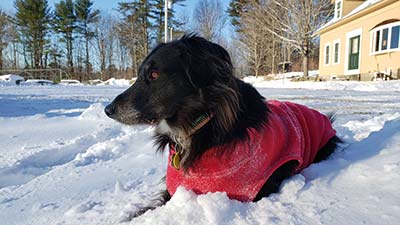 Last but not least, I want to show YOU, our treasured followers and customers, more of this farming life. I'll go beyond the curated (oh, how I hate that word!) Instagram photos to include short videos of my day-to-day tasks, more photos of the good, the bad and the ugly sides of farming, more links to interesting articles and frequent short blog entries. And, of course, more photos of Suzie, our beloved farm dog, because, well…everyone loves dogs. I believe that we all need to be more connected to how our food is grown, fully understanding the trials and costs of bringing food to market. I want people to see how difficult it can be to get that perfect tomato or beautiful egg, the work it takes to restore the land, the challenges faced in successfully growing good food for our neighbors. By being informed, we can make better choices about where to spend our hard-earned dollars on nutritious, healthy food grown in ways we can understand and feel good about. I can get all soap-boxy about real food and good food choices because I truly believe food is not just about eating but about our community, our planet, and our health. The further away industrial agriculture takes us from our food, the more all those things suffer. We'd like to be just one tiny positive influence toward the return to real food.
Last but not least, I want to show YOU, our treasured followers and customers, more of this farming life. I'll go beyond the curated (oh, how I hate that word!) Instagram photos to include short videos of my day-to-day tasks, more photos of the good, the bad and the ugly sides of farming, more links to interesting articles and frequent short blog entries. And, of course, more photos of Suzie, our beloved farm dog, because, well…everyone loves dogs. I believe that we all need to be more connected to how our food is grown, fully understanding the trials and costs of bringing food to market. I want people to see how difficult it can be to get that perfect tomato or beautiful egg, the work it takes to restore the land, the challenges faced in successfully growing good food for our neighbors. By being informed, we can make better choices about where to spend our hard-earned dollars on nutritious, healthy food grown in ways we can understand and feel good about. I can get all soap-boxy about real food and good food choices because I truly believe food is not just about eating but about our community, our planet, and our health. The further away industrial agriculture takes us from our food, the more all those things suffer. We'd like to be just one tiny positive influence toward the return to real food.
So, stay tuned! Follow us on Facebook, Instagram and Twitter. We look forward to all of the possibilities that 2020 brings and to seeing you all at the market in June!